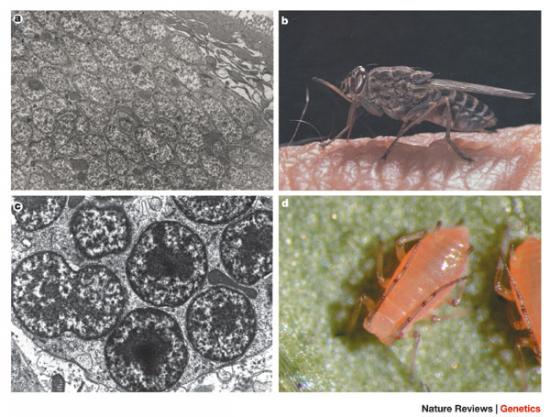
Panel a courtesy of Serap Aksoy, Yale University; panel b reproduced with permission from the cover of Parasitology Today (October) © (1991) Elsevier Science, photograph by K. D. Taylor, University of Bristol; panels c, d courtesy of Josh White and Nancy Moran, respectively, University of Arizona.
P-endosymbionts of insects are characterized by their occurrence in specialized host cells called bacteriocytes, which are located at various positions in the insect body depending on the host group1. Bacteriocytes are sometimes grouped into organ-like structures called bacteriomes (or mycetomes) that occur in the body cavity of aphids and in the anterior gut region of tsetse flies. Bacteriocytes that contain Blochmannia, the P-endosymbiont of the ant genus Camponotus, do not form aggregates but are intercalated among ant midgut epithelial cells2, 18, 75, 76. In the bacteriocyte, symbiont cells occur in host-derived vesicles (for example, Buchnera) or directly in the bacteriocyte cytoplasm (such as Wigglesworthia and Blochmannia). Symbionts of mealybugs provide a fascinating example of cellular integration. These gamma-3 subdivision proteobacterial symbionts exist in the cells of a second, beta-subdivision proteobacterial symbiont called Tremblaya princeps77, 78. Panels a and b show Wigglesworthia cells and their tsetse fly host, respectively; panels c and d show Buchnera and its aphid host (Acyrthosiphon pisum), respectively.







